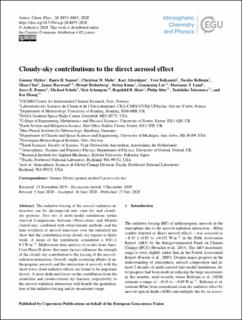| dc.contributor.author | Myhre, Gunnar | |
| dc.contributor.author | Samset, Bjørn Hallvard | |
| dc.contributor.author | Mohr, Christian Wilhelm | |
| dc.contributor.author | Alterskjær, Kari | |
| dc.contributor.author | Balkanski, Yves | |
| dc.contributor.author | Bellouin, Nicolas | |
| dc.contributor.author | Chin, Mian | |
| dc.contributor.author | Haywood, James | |
| dc.contributor.author | Hodnebrog, Øivind | |
| dc.contributor.author | Kinne, Stefan | |
| dc.contributor.author | Lin, Guangxing | |
| dc.contributor.author | Lund, Marianne Tronstad | |
| dc.contributor.author | Penner, Joyce E. | |
| dc.contributor.author | Schulz, Michael | |
| dc.contributor.author | Schutgens, Nick | |
| dc.contributor.author | Skeie, Ragnhild Bieltvedt | |
| dc.contributor.author | Stier, Philip | |
| dc.contributor.author | Takemura, Toshihiko | |
| dc.contributor.author | Zhang, Kai | |
| dc.date.accessioned | 2021-08-24T09:27:26Z | |
| dc.date.available | 2021-08-24T09:27:26Z | |
| dc.date.created | 2020-09-29T20:15:59Z | |
| dc.date.issued | 2020 | |
| dc.identifier.citation | Atmospheric Chemistry and Physics. 2020, 20 8855-8865. | en_US |
| dc.identifier.issn | 1680-7316 | |
| dc.identifier.uri | https://hdl.handle.net/11250/2770912 | |
| dc.description.abstract | The radiative forcing of the aerosol–radiation interaction can be decomposed into clear-sky and cloudy-sky portions. Two sets of multi-model simulations within Aerosol Comparisons between Observations and Models (AeroCom), combined with observational methods, and the time evolution of aerosol emissions over the industrial era show that the contribution from cloudy-sky regions is likely weak. A mean of the simulations considered is 0.01±0.1 W m−2. Multivariate data analysis of results from AeroCom Phase II shows that many factors influence the strength of the cloudy-sky contribution to the forcing of the aerosol–radiation interaction. Overall, single-scattering albedo of anthropogenic aerosols and the interaction of aerosols with the short-wave cloud radiative effects are found to be important factors. A more dedicated focus on the contribution from the cloud-free and cloud-covered sky fraction, respectively, to the aerosol–radiation interaction will benefit the quantification of the radiative forcing and its uncertainty range. | en_US |
| dc.language.iso | eng | en_US |
| dc.publisher | Copernicus publications | en_US |
| dc.rights | Navngivelse 4.0 Internasjonal | * |
| dc.rights.uri | http://creativecommons.org/licenses/by/4.0/deed.no | * |
| dc.title | Cloudy-sky contributions to the direct aerosol effect | en_US |
| dc.type | Journal article | en_US |
| dc.type | Peer reviewed | en_US |
| dc.description.version | publishedVersion | en_US |
| dc.source.pagenumber | 8855-8865 | en_US |
| dc.source.volume | 20 | en_US |
| dc.source.journal | Atmospheric Chemistry and Physics | en_US |
| dc.identifier.doi | 10.5194/acp-20-8855-2020 | |
| dc.identifier.cristin | 1835170 | |
| dc.relation.project | Norges forskningsråd: 295046 | en_US |
| dc.relation.project | Notur/NorStore: NS9252K | en_US |
| cristin.ispublished | true | |
| cristin.fulltext | original | |
| cristin.qualitycode | 2 | |

